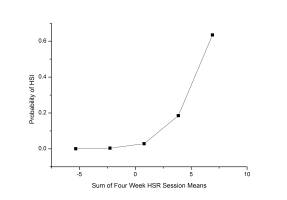Effect of high-speed running on hamstring strain injury risk
Journal article
Duhig, Steven, Shield, Anthony, Opar, David, Gabbett, Tim, Ferguson, Cameron and Williams, Morgan. (2016). Effect of high-speed running on hamstring strain injury risk. British Journal of Sports Medicine. 50(24). https://doi.org/10.1136/bjsports-2015-095679
| Authors | Duhig, Steven, Shield, Anthony, Opar, David, Gabbett, Tim, Ferguson, Cameron and Williams, Morgan |
|---|---|
| Abstract | Background Hamstring strain injuries (HSIs) are common within the Australian Football League (AFL) with most occurring during high-speed running (HSR). Therefore, this study investigated possible relationships between mean session running distances, session ratings of perceived exertion (s-RPE) and HSIs within AFL footballers. Methods Global positioning system (GPS)-derived running distances and s-RPE for all matches and training sessions over two AFL seasons were obtained from one AFL team. All HSIs were documented and each player's running distances and s-RPE were standardised to their 2-yearly session average, then compared between injured and uninjured players in the 4 weeks (weeks −1, −2, −3 and −4) preceding each injury. Results Higher than ‘typical’ (ie, z=0) HSR session means were associated with a greater likelihood of HSI (week −1: OR=6.44, 95% CI=2.99 to 14.41, p < 0.001; summed weeks −1 and −2: OR=3.06, 95% CI=2.03 to 4.75, p < 0.001; summed weeks −1, −2 and −3: OR=2.22, 95% CI=1.66 to 3.04, p < 0.001; and summed weeks −1, −2, −3 and −4: OR=1.96, 95% CI=1.54 to 2.51, p < 0.001). However, trivial differences were observed between injured and uninjured groups for standardised s-RPE, total distance travelled and distances covered whilst accelerating and decelerating. Increasing AFL experience was associated with a decreased HSI risk (OR=0.77, 95% CI 0.57 to 0.97, p=0.02). Furthermore, HSR data modelling indicated that reducing mean distances in week −1 may decrease the probability of HSI. Conclusions Exposing players to large and rapid increases in HSR distances above their 2-yearly session average increased the odds of HSI. However, reducing HSR in week −1 may offset HSI risk. |
| Year | 2016 |
| Journal | British Journal of Sports Medicine |
| Journal citation | 50 (24) |
| ISSN | 1473-0480 |
| Digital Object Identifier (DOI) | https://doi.org/10.1136/bjsports-2015-095679 |
| Scopus EID | 2-s2.0-84977571670 |
| Open access | Open access |
| Research Group | Sports Performance, Recovery, Injury and New Technologies (SPRINT) Research Centre |
| Author's accepted manuscript | License File Access Level Open |
| Publisher's version | File Access Level Controlled |
| Supplemental file | |
| Supplemental file | |
| Supplemental file |
https://acuresearchbank.acu.edu.au/item/8930v/effect-of-high-speed-running-on-hamstring-strain-injury-risk
Download files
Author's accepted manuscript
| AM_Duhig_2016_Effect_of_high_speed_running_on_hamstring.pdf | |
| License: CC BY-NC | |
| File access level: Open | |
Supplemental file
Restricted files
Publisher's version
672
total views3321
total downloads5
views this month4
downloads this month


